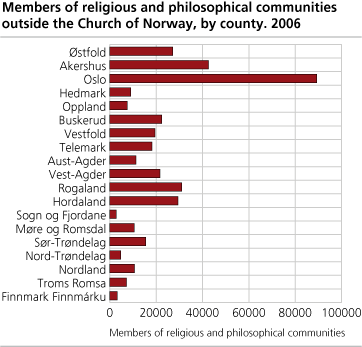Content
Published:
This is an archived release.
383 500 members in religious and philosophical communities
In January 2006, about 383 500 persons, or 8 per cent of the population, were registered as members of religious and philosophical communities. This is a small increase compared with the previous year. The communities receive central government subsidies and do not belong to the Church of Norway.
Slightly more than 50 per cent, or 216 000 people, are members of Christian communities. 77 300 people are members of philosophical communities and accounted for approximately 20 per cent of all members of communities outside the Church of Norway. The Norwegian Humanist Association is the largest philosophical community with 76 470 members. Islamic communities have 72 000 members, or almost 19 per cent of all members in religious and philosophical communities. Buddhism, Hinduism and Sikhism account for 3 per cent, 1 per cent and 0.6 per cent of members respectively.
|
The statistics are based on the annual application forms which the religious and philosophical communities submit to the county governor when they apply for central government subsidies. The member lists of the religious and philosophical communities are sent electronically to the Brønnøysund Register Centre via the county governor for control and elimination of duplicates. The statistics for 2005 and 2006 are not comparable with previous years, since the basis of the data has been changed. |
Tables:
- Table 1 Members of religious and philosophical communities outside the Church of Norway, by religion/philosophy. Per 1.1. 2005 and 2006. Numbers and per cent
- Table 2 Members of religious and philosophical communities outside the Church of Norway. Religion/philosophical community. County. 2006
- Table 3 Members of Christian communities outside the Church of Norway. Per 1.1. 2005 and 2006
Additional information
The statistics include members of religious and life stance communities based on annual applications for central government subsidies. Some communities do not apply for subsidies every year. Due to this fact, the number of members in some categories varies some years. Some communities never apply for subsidies.
Contact
-
Andreas Østhus
E-mail: andreas.osthus@ssb.no
tel.: (+47) 47 64 99 08
-
Andrea Ihler Evensen
E-mail: andreaihler.evensen@ssb.no
tel.: (+47) 93 06 06 87

